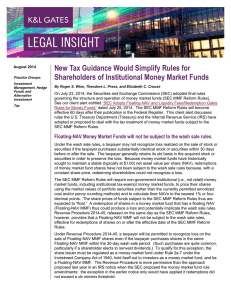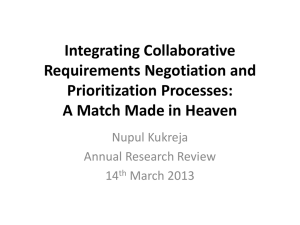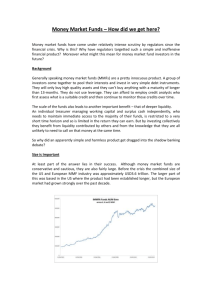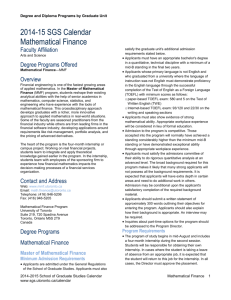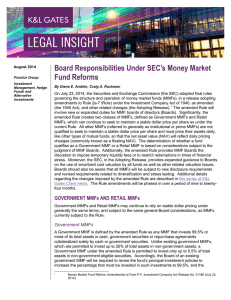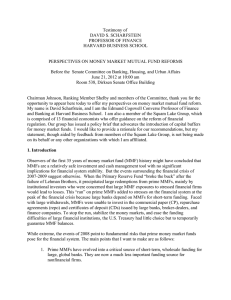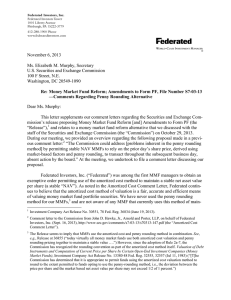IRS Guidance Regarding Money Market Mutual Funds
advertisement
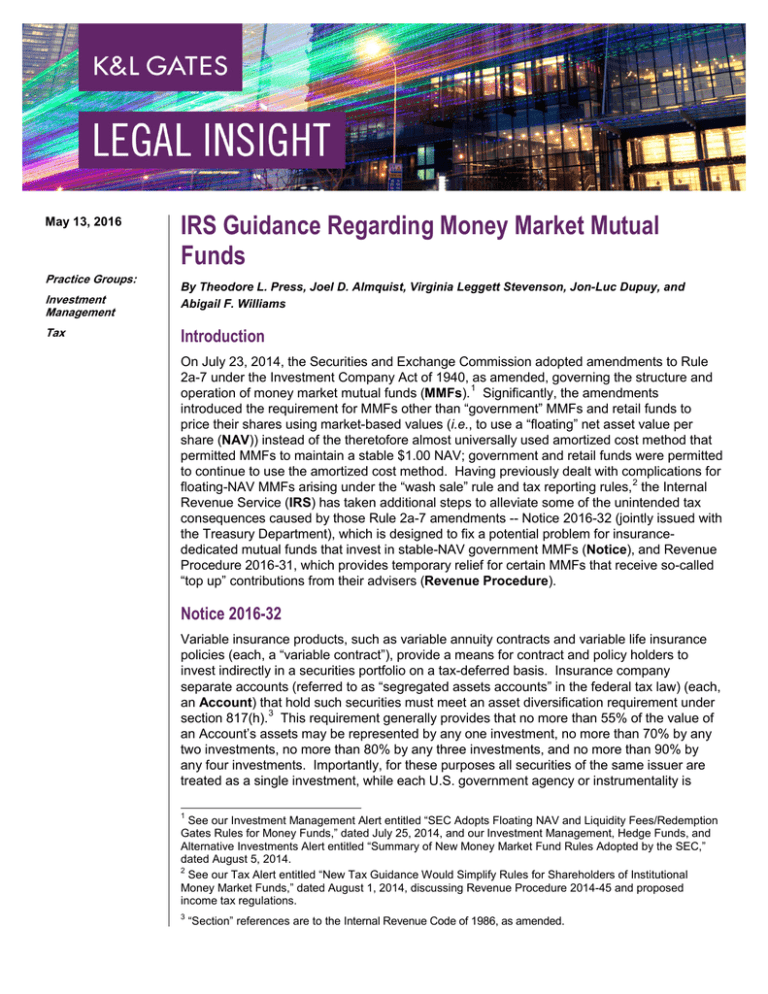
May 13, 2016 Practice Groups: Investment Management Tax IRS Guidance Regarding Money Market Mutual Funds By Theodore L. Press, Joel D. Almquist, Virginia Leggett Stevenson, Jon-Luc Dupuy, and Abigail F. Williams Introduction On July 23, 2014, the Securities and Exchange Commission adopted amendments to Rule 2a-7 under the Investment Company Act of 1940, as amended, governing the structure and operation of money market mutual funds (MMFs). 1 Significantly, the amendments introduced the requirement for MMFs other than “government” MMFs and retail funds to price their shares using market-based values (i.e., to use a “floating” net asset value per share (NAV)) instead of the theretofore almost universally used amortized cost method that permitted MMFs to maintain a stable $1.00 NAV; government and retail funds were permitted to continue to use the amortized cost method. Having previously dealt with complications for floating-NAV MMFs arising under the “wash sale” rule and tax reporting rules, 2 the Internal Revenue Service (IRS) has taken additional steps to alleviate some of the unintended tax consequences caused by those Rule 2a-7 amendments -- Notice 2016-32 (jointly issued with the Treasury Department), which is designed to fix a potential problem for insurancededicated mutual funds that invest in stable-NAV government MMFs (Notice), and Revenue Procedure 2016-31, which provides temporary relief for certain MMFs that receive so-called “top up” contributions from their advisers (Revenue Procedure). Notice 2016-32 Variable insurance products, such as variable annuity contracts and variable life insurance policies (each, a “variable contract”), provide a means for contract and policy holders to invest indirectly in a securities portfolio on a tax-deferred basis. Insurance company separate accounts (referred to as “segregated assets accounts” in the federal tax law) (each, an Account) that hold such securities must meet an asset diversification requirement under section 817(h). 3 This requirement generally provides that no more than 55% of the value of an Account’s assets may be represented by any one investment, no more than 70% by any two investments, no more than 80% by any three investments, and no more than 90% by any four investments. Importantly, for these purposes all securities of the same issuer are treated as a single investment, while each U.S. government agency or instrumentality is 1 See our Investment Management Alert entitled “SEC Adopts Floating NAV and Liquidity Fees/Redemption Gates Rules for Money Funds,” dated July 25, 2014, and our Investment Management, Hedge Funds, and Alternative Investments Alert entitled “Summary of New Money Market Fund Rules Adopted by the SEC,” dated August 5, 2014. 2 See our Tax Alert entitled “New Tax Guidance Would Simplify Rules for Shareholders of Institutional Money Market Funds,” dated August 1, 2014, discussing Revenue Procedure 2014-45 and proposed income tax regulations. 3 “Section” references are to the Internal Revenue Code of 1986, as amended. IRS Guidance Regarding Money Market Mutual Funds treated as a separate issuer. An Account also will be “adequately diversified” if it satisfies the diversification standard for “regulated investment companies” (which include MMFs) (each, a RIC) under Subchapter M, provided that no more than 55% of the Account’s assets are cash, cash items, government securities, or securities of other RICs. An Account may meet the section 817(h) diversification requirement by investing in an “insurance-dedicated” RIC that has an investment portfolio meeting the requirement. An insurance-dedicated RIC is one that offers its shares only to insurance company separate and general accounts, retirement plans, and certain other similar tax-deferred investors (and the fund manager under certain circumstances) and may be “looked through” for purposes of satisfying the requirement. The amendment to Rule 2a-7 means that many MMFs will no longer be able to maintain a stable NAV for their shares. An exception is provided for a “government” MMF (i.e., an MMF that invests at least 99.5% of its total assets in cash, government securities, and/or repurchase agreements that are collateralized by government securities or cash). Such a fund will be permitted to continue to use amortized cost accounting to maintain a stable per share NAV. The fund industry has raised concerns that insurance-dedicated government MMFs could have difficulty meeting the section 817(h) diversification requirement given the limited number of different U.S. government agency and instrumentality issuers of securities that are MMF-eligible under Rule 2a-7 and the expected increased demand for those securities in light of the anticipated growth of government MMFs following the full implementation of the amended rule. The Notice states that the Treasury Department and the IRS have determined that variable contracts should be able to offer government MMFs as an investment option. Accordingly, the Notice provides an alternative diversification requirement so that an Account that invests solely in an insurance-dedicated government MMF can meet the section 817(h) diversification requirement. Under the alternative requirement contained in the Notice (on which “taxpayers may rely pending the promulgation of future administrative or regulatory guidance”), an Account is adequately diversified under section 817(h) if (1) no policyholder has investor control and (2) either (a) the Account itself is a government MMF under Rule 2a–7(a)(14) or (b) the Account invests all of its assets in an investment company, partnership, or trust that satisfies the “look-through” requirements under the regulations and qualifies as such a government MMF. Note that the alternative requirement applies, in the case of an Account that is not itself a government MMF, only if the Account invests all of its assets in an insurance-dedicated RIC or other “look-through” vehicle. For these purposes, the tax term “segregated asset account” should include a sub-account of a separate account that consists of all assets the investment return and market value of each of which is allocated in an identical manner to any variable contract invested therein. The Notice does not, however, extend its relief to fund-of-funds structures where an Account invests in an insurance-dedicated fund that, in turn, invests in a portfolio of lower-tier funds that includes an insurance-dedicated government MMF. In addition, the Notice does not provide relief to Accounts in which an insurance-dedicated government MMF is only one of several investments that the Account holds. 2 IRS Guidance Regarding Money Market Mutual Funds Revenue Procedure 2016-31 The IRS also released Revenue Procedure 2016-31, which provides temporary relief for certain MMFs that receive contributions from their advisers as the funds transition to comply with new share pricing rules under amended Rule 2a-7. Historically, MMFs have sought to keep a stable NAV (typically at $1.00) at which their shares are distributed and redeemed. Under amended Rule 2a-7, the NAV of the shares of many MMFs will be based on the market values of their portfolios, causing the NAVs to vary from day to day (a floating-NAV). The investment adviser of an MMF that converts to a floating NAV may want to make a contribution to the MMF so that the initial floating NAV of the shares will match the stable NAV that exists immediately before the transition (a “top up” contribution). An MMF must meet distribution requirements to be taxed as a RIC under Subchapter M (specifically section 852(a)(1)) and to avoid the imposition of an excise tax under section 4982. A RIC also is subject to federal income tax on its investment company taxable income (ICTI) (defined under section 852(b)(2)). The Revenue Procedure, acknowledging that if the distribution requirements in sections 852 and 4982 apply to top up contributions, it may be impossible or impractical for some MMF advisers to make contributions so that shareholders will receive the same value per share both before and after the MMF’s transition to a floating NAV, states that it is in the interest of sound tax administration to apply section 852 in a manner that will help facilitate a smooth transition to compliance with the amended MMF rules. It goes on to provide, however, that the Treasury Department and the IRS do not believe those contributions should be excluded from a RIC’s income for other federal tax purposes. The Revenue Procedure thus permits an MMF to exclude a top up contribution from its ICTI for purposes of the distribution requirement in section 852(a)(1). A top up contribution will, however, be included in an MMF’s ICTI under section 852(b)(2), and the MMF thus will be required to pay federal income tax on that amount (since it will not be able to qualify for a dividends-paid deduction therefor). As a result of federal income tax having been paid thereon, the top up contribution will be deemed to have been distributed for purposes of determining the MMF’s liability for the section 4982 excise tax on under-distributions. This treatment thus provides an MMF with a relatively straightforward path for calculating the amount of the top up contribution needed to achieve the purpose of such a contribution. It is important to note that this is very limited relief. It applies only to contributions made in connection with the transition of certain MMFs to a floating NAV before the October 14, 2016, compliance deadline for making that transition. 3 IRS Guidance Regarding Money Market Mutual Funds Authors: Theodore L. Press ted.press@klgates.com +1.202.778.9025 Joel D. Almquist joel.almquist@klgates.com +1.617.261.3104 Virginia Leggett Stevenson virginia.stevenson@klgates.com +1.704.331.7512 Jon-Luc Dupuy jon-luc.dupuy@klgates.com +1.617.261.3146 Abigail F. Williams abigail.williams@klgates.com +1.704.331.7430 Anchorage Austin Fort Worth Frankfurt Orange County Beijing Palo Alto Berlin Harrisburg Paris Boston Hong Kong Perth Brisbane Houston Pittsburgh Brussels London Portland Charleston Los Angeles Raleigh Charlotte Melbourne Research Triangle Park Chicago Miami Dallas Milan San Francisco Doha Newark Dubai New York São Paulo Seattle Seoul Shanghai Singapore Sydney Taipei Tokyo Warsaw Washington, D.C. Wilmington K&L Gates comprises approximately 2,000 lawyers globally who practice in fully integrated offices located on five continents. The firm represents leading multinational corporations, growth and middle-market companies, capital markets participants and entrepreneurs in every major industry group as well as public sector entities, educational institutions, philanthropic organizations and individuals. For more information about K&L Gates or its locations, practices and registrations, visit www.klgates.com. This publication is for informational purposes and does not contain or convey legal advice. The information herein should not be used or relied upon in regard to any particular facts or circumstances without first consulting a lawyer. © 2016 K&L Gates LLP. All Rights Reserved. 4
